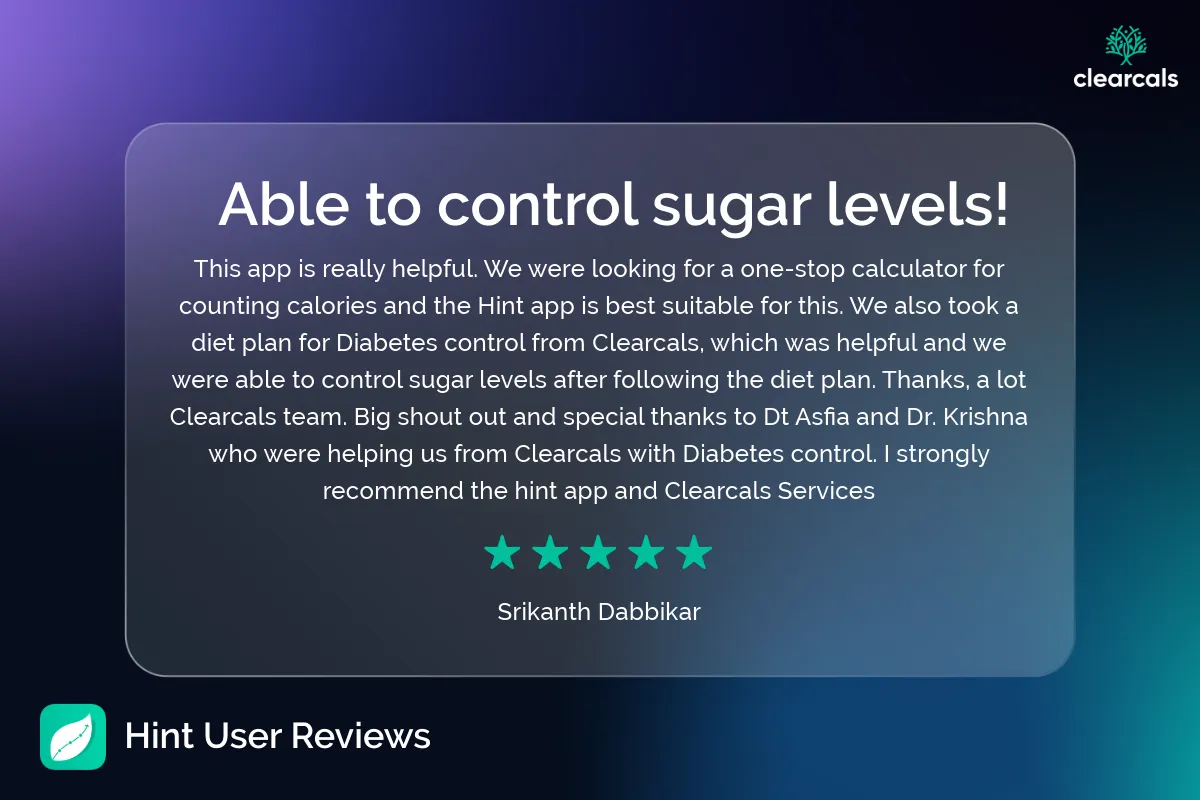Looking for a Personalized Diet Plan?
Manage Diabetes Effortlessly with the Indian Diabetic Diet Chart

Diabetes is a chronic condition that affects millions worldwide, and its management requires a comprehensive approach.
According to the World Health Organization (WHO), diabetes occurs when the pancreas does not produce enough insulin, or when the body cannot effectively use the insulin it produces.
There are three main types: Type 1 diabetes, Type 2 diabetes, and gestational diabetes.
Type 2 diabetes, the most common form, is primarily linked to lifestyle factors such as a sedentary lifestyle, poor diet, and lack of awareness about proper diabetes management.
With early diagnosis and lifestyle modifications, it is possible to prevent the onset of Type 2 diabetes or manage it effectively through a combination of medical nutrition therapy and physical activity.
The Indian Diabetic Diet Chart, available through Hint Pro, provides a scientifically backed, personalized plan designed to manage blood sugar levels and prevent diabetes-related complications.
Managing Diabetes Effectively with the Indian Diabetic Diet Chart
One of the most effective ways to manage diabetes is through proper diet.
The Indian Diabetic Diet Chart is specifically designed to help individuals manage their blood sugar levels and prevent diabetes-related complications.
By focusing on balanced nutrition, portion control, and the inclusion of low glycemic index foods, this diet plan can stabilize blood sugar levels and reduce the risk of comorbidities like heart disease, kidney damage, and nerve issues.
The Indian Diabetic Diet Chart emphasizes whole grains, fiber-rich fruits, vegetables, and healthy fats while reducing refined sugars and simple carbohydrates.
This balanced approach helps in managing post-meal blood sugar spikes and supports overall metabolic health.
Preventing Diabetes-Related Complications
Uncontrolled diabetes can lead to severe complications such as cardiovascular diseases, stroke, high blood pressure, and nerve damage.
The personalized Indian Diabetic Diet Chart offered through Hint Pro not only helps manage blood sugar but also mitigates the risk of these life-threatening complications.
With the Hint Pro subscription, you can access a tailored diet plan that addresses your unique health needs, ensuring better long-term diabetes management.

How the Hint App Helps Manage Diabetes
The Hint app is an invaluable tool for anyone looking to manage diabetes more effectively.
With its personalized Indian Diabetic Diet Chart, users receive tailored meal plans that suit their lifestyle and health goals. Here’s how Hint makes diabetes management easier:
- Personalized Meal Plans: The Hint app creates a customized diabetic diet plan based on your health profile, activity levels, and dietary preferences, ensuring your meals are both healthy and enjoyable.
- Advanced Nutrient Tracking: Track essential nutrients like carbohydrates, fiber, and sugars to ensure you're following the diet closely and managing your blood sugar levels effectively.
- Calorie Tracking: With Hint’s advanced calorie-tracking features, you can monitor your intake to maintain a healthy weight, a critical aspect of managing diabetes.
- Workout Plans: The app also provides personalized workout routines that complement your diet and help regulate blood sugar.
- Reminders and Progress Tracking: Stay consistent with reminders for meals, medications, and physical activity, while tracking your progress over time.
With the Hint Pro subscription, users get access to these advanced features, helping them manage their condition proactively.
The Importance of Expert Guidance
While diet plays a critical role in managing diabetes, expert guidance from a qualified dietitian can significantly enhance the effectiveness of any diet plan.
Through the Hint Premium subscription, you can consult with certified dietitians who specialize in diabetes management.
These experts provide personalized advice based on your health profile, ensuring that your diet is not only effective but sustainable.
Consulting a dietitian can also help you make informed choices about portion sizes, meal timings, and how to integrate healthy eating habits into your daily routine.
This one-on-one support ensures that your blood sugar levels remain stable, reducing the need for medication and preventing complications.
Scientific Evidence Supporting Nutrition Therapy
Research consistently shows that medical nutrition therapy (MNT) can greatly improve glycemic control in individuals with diabetes.1,2
A study comparing low-carbohydrate and low-fat diets found that participants on low-carb diets experienced significant improvements in HbA1c levels, reduced triglycerides, and increased HDL cholesterol levels.3
Another study concluded that a low glycemic index diet offered better blood sugar control than a high glycemic index diet for people with Type 2 diabetes.4
These findings highlight the importance of choosing the right dietary approach, and with Hint Pro and Hint Premium, you have access to scientifically backed diet plans and professional guidance that can help you manage diabetes effectively.
References
- Diet, nutrition and the prevention of chronic diseases: report of a Joint WHO/FAO expert consultation, Geneva, 28 January - 1 February 2002
- Franz MJ, MacLeod J, Evert A, et al. (PDF) Academy of Nutrition and Dietetics Nutrition Practice Guideline for Type 1 and Type 2 Diabetes in Adults Systematic Review of Evidence for Medical Nutrition Therapy Effectiveness and Recommendations for Integration into the Nutrition Care Process J Acad Nutr Diet 2017;117:1659–1679 10.
- van Zuuren EJ, Fedorowicz Z, Kuijpers T, Pijl H.Effects of low-carbohydrate- compared with low-fat-diet interventions on metabolic control in people with type 2 diabetes: a systematic review including GRADE assessments Am J Clin Nutr 2018;108:300–331
- Ojo O., Ojo O.O., Adebowale F., Wang X.-H. The Effect of Dietary Glycaemic Index on Glycaemia in Patients with Type 2 Diabetes: A Systematic Review and Meta-Analysis of Randomized Controlled Trials. Nutrients. 2018;10:373






